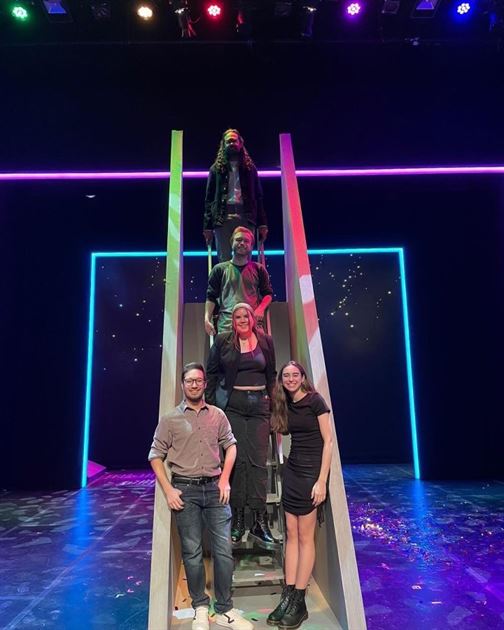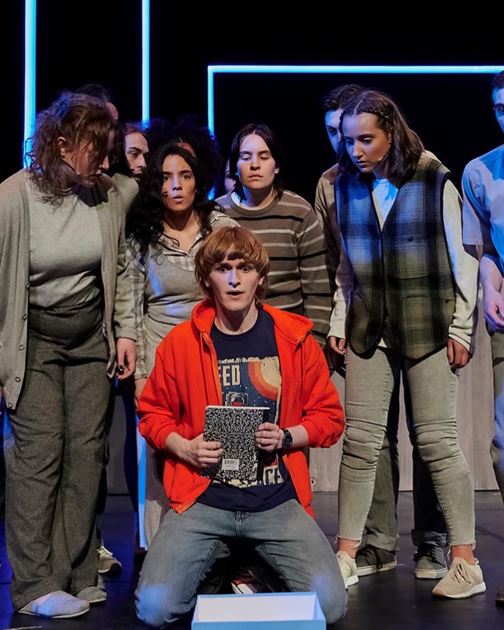Costume design always involves a great deal of research and planning. But for the recent Montclair State University production of “The Curious Incident of the Dog in the Night-Time,” costume designer Katherine Victoria Repp, a junior in the theatre, design, technology and management program, went above and beyond to learn more about ethical clothing sources and accessibility.
“Researching accessible clothing was really important to the authenticity of this show and researching where these clothes come from was an important thing for me, personally, as a designer,” Repp said. “Designing has made me increasingly aware of how costuming can sometimes be a wasteful practice since clothes are typically bought with speed and price in mind. This, unfortunately, leads to purchasing from unethical sources such as Amazon and Shein.”
When purchasing her costume pieces, Repp tried to avoid fast fashion companies that exploit their workers and make clothing as cheaply as possible. Instead, she opted for well-made, timeless basics to make up her neutral base costumes.
The items she bought will become part of costume stock to be used in many other shows. Sustainable shopping is not one of the foundations of costuming, though Repp is developing a knack for it.
“I wouldn’t say that it makes it harder, but it definitely is a tool that takes time and practice to develop,” Repp said. “This show gave me a plethora of outstanding resources in terms of sustainable stores, as well as methods of determining what stores are ‘safe’ versus which are unethical.”

Scenic designer Louis Medrano, lighting designer Justin Stuart, Katherine Victoria Repp, assistant scenic designer Frank Scarnaty Jr., and assistant stage manager Miranda Rhode.
Photo courtesy of Markus Johnson
Using what she learned in “The Curious Incident of the Dog in the Night-Time,” Repp hopes to continue her more sustainable practices as the costume designer for next semester’s production of “Pippin.”
“In my next show, I plan on continuing to use my main resource which was goodonyou.com,” Repp said. “This website has an amazing directory. I will also keep utilizing thrift stores and second-hand stores, as well as small costume artisans and businesses.”
In addition to sustainable sourcing, Repp also researched how the main character’s sensory issues would impact the clothing he wears. The way Christopher perceives the world was crucial to Repp’s design concept.
“The overall concept of the show was to show the world through Christopher’s eyes,” Repp said. “For me, as a designer, that meant that Christopher’s clothes had to accommodate his needs.”
Because the character of Christopher is neurodivergent, Repp had to take special care in her design decisions.
“I found what parents had done for their children with similar needs as Christopher,” Repp said. “His jeans are specifically made to allow for movement and are made with an elastic waistband to help Christopher dress himself. Another thing we did was use elastic laces on his shoes. Converse specifically was recommended by a mom who said that her son preferred them, due to the security around the ankle and the flatness of the soles.”

Andrew Linden as Christopher and the ensemble of “The Curious Incident of the Dog in the Night-Time.”
Photo courtesy of Gennadi Novash
Having researched accessible clothing items for Christopher, some of Repp’s newfound knowledge also made its way into her designs for other characters. One elderly character, for example, wore a sweater with back closures designed to provide access to nursing assistance. In that way, considerations of accessibility were not limited to Christopher but became part of the broader fabric of her show.
Her work and effort do not go unnoticed, especially by classmate Justin Stuart, a senior theatre production/design major and also the lighting director for “Curious Incident.”
“I think [Repp’s] big success was costuming an ensemble in modern attire so well,” Stuart said. “They all melt into the background when the focus isn’t on them, but when they’re present, you feel it.”
Her director and associate professor of theatre and dance, Heather Benton, also had high praise for Repp’s work in sustainable costume design.
“My experience collaborating with [Repp] on ‘Curious Incident’ was wonderful,” Benton said. “From the beginning, [Repp] was very committed to researching and finding accessible clothing for the character of Christopher, and her design was deeply influenced by the nuances of Christopher’s character as articulated in the novel, in particular, the way he responds to certain colors and the mathematical properties of patterns.”
Above all, Repp’s goal was to give audiences a way into Christopher’s headspace and foster empathy with his experiences.
“This show taught me about how many things go into the clothes we wear, not in just the obvious ways, but also [in terms of] how we put them on and how textures, seams, closures, etc., make us feel,” Repp said. “[Also], how these things can change our mood and either serve or debilitate us. I hope this [allowed] audiences to sympathize with Christopher and really see what his world looks and feels like.”



